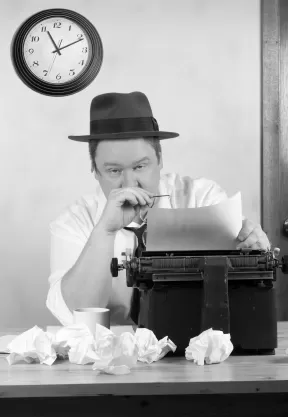Win strategies and themes for your proposal aren’t created. They evolve. They don’t come from a sudden inspiration. They come from finding positions that match the customer’s needs. They start from looking at areas of customer concern and matching them with approaches to fulfillment that match your attributes. As you learn more about the customer, the opportunity, and the competitive environment and as you go from general to specific, you modify your positioning. It’s much easier to understand if you think of it as evolution. You start with the areas of customer concern and over time refine your positioning.
Of course that’s not what most people do. What usually happens on most pursuits is that win strategies and themes are created at the last minute:
- By making something up because someone realizes that you’re supposed to have some themes and you don’t.
- Because your bid justification report is supposed to have some, but you don’t have an RFP or any evaluation criteria to base them on.
- By trying to come up with something for each heading in your outline.
- By trying to be whatever will score the highest with only the evaluation criteria to go by.
- Based on your own capabilities, qualifications, and strengths.
- Because your template has placeholders for them and you have to fill them in.
Win strategies and themes come from many sources. So it’s good to consider things like your capabilities, qualifications, and strengths, or the evaluation criteria. It’s good if each section of your proposal substantiates one or more reasons why the customer should select you. But they should also be based on the customer, opportunity, and competitive intelligence you’ve collected. And they should be written from the customer’s perspective instead of from your own.
Ultimately, you need your themes to add up to what it’s going to take to win. To do that, you have to discover what it will take to win. As you uncover things that are part of what it’s going to take to win, you identify areas where you should explore how to best position your company. That is where the evolution of your win strategies and themes should start.
This exploration often starts with questions. What matters to the customer? What matters about how this project will play out? What will be needed to achieve success on the project? What will be needed to win the procurement process? The initial answers will be at a high level and will start to form categories like:
- The best offering
- The lowest price or the best value
- The highest evaluation score
- Being perceived as trustworthy by the customer
- Exceeding mere compliance in a way that differentiates you from the competition
As you explore each category, you define what it will take to win in more detail, leading to more detailed win strategies and themes.
When the RFP is released and you have a proposal outline and evaluation criteria, you can match what you have against the structure of the document. When you have gaps, you don’t just make something up out of thin air, you see if any of your categories can be extended or applied to cover the topics addressed in that section of the proposal. This is also how you achieve a hierarchy of themes and commonality of message from the Executive Summary down to each section, without having to wait until you know the document structure to work out your messages.
The key to implementing this approach is to treat win strategies and themes as something that evolves and not as something that gets created. Think of them as categories and not as statements. Think of them as areas of concern and focus. Then when you start each section, start by considering how the section relates to the areas of concern and what message that section needs to deliver, then write the section by substantiating the message.
The result will be a proposal that actually says something that matters because it was written based on areas of customer concern. If you are careful with the writing and you make sure that the proposal is written from the customer’s perspective, then your proposal will end up being about how you satisfy their concerns. If you are the customer and you have to pick between that and a document full of platitudes that aren’t based on anything or shallowly parrot the evaluation criteria published in the RFP, which would you pick?
That's why when we created our MustWin Process we set it up so that the pre-RFP intelligence gathering activities result in an awareness of what it will take to win. Then our Proposal Content Planning methodology can take that awareness and turn it into themes for the proposal. The result is that the win strategies and themes evolve over time and everything in the proposal can be traced back to what it will take to win.
What I have found since creating it is that it helps inspire me when I write proposals and I can more quickly get into a groove because I know what to write about. The details that go into the proposal are easy. It's getting the context right so that you know how to express those details that's hard. Instead of trying to create win strategies and themes that are both persuasive and fully integrated in one step, the process enables them to evolve in a way that is more natural and more productive.



Join the conversation
You can post now and register later. If you have an account, sign in now to post with your account.
Note: Your post will require moderator approval before it will be visible.